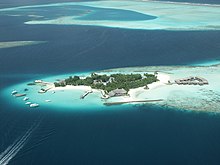 | |
| General characteristics | |
|---|---|
| Coastline | 640 km (400 mi)[1] |
| EEZ area | 923,000 km2 (356,000 sq mi)[2] |
| EEZ PP | 387 mg or 5.97 gr C/m²/day[2] |
| Shelf area | 35,000 km2 (14,000 sq mi)[2] |
| Land area | 300 km2 (120 sq mi)[1] |
| Employment | Full-time: 22,000 (1996)[3] Part-time: 5,000 (1996)[3] |
| Fishing fleet | 1,674 vessels, nearly all motorised (1995)[3] |
| Export value | US$ 56 million (1997) [3] |
| Import value | nil |
| Harvest | |
| Wild marine | 184,158 tonnes (202,999 tons) (2006)[4] |
| Aquaculture total | nil |
The fishing industry in the Maldives is the island's second main industry. According to national tradition in the words of former President Maumoon Abdul Gayoom, "Fishing is the lifeblood of our nation, it is inborn. From the soil on which we live, to the sea around us, it remains an integral part of our existence. Fishing, and our country and its people, [are] one and shall remain inseparable forever."[5] The Maldives has an abundance of aquatic life and species of fish. Common are tuna, groupers, dolphin fish, barracuda, rainbow runner, trevally and squirrelfish and many more. Aside from being of essential importance to the economy, fishing is also a popular recreational activity in the Maldives, not only among locals but by tourists. The islands have numerous fishing resorts which cater for these activities.
The Maldives is an archipelago in the Indian Ocean, located southwest of the southern tip of India. Its population in 2008 was 386,000.[1] There are twenty-six atolls containing 1,192 islets, of which two hundred and fifty islands are inhabited. The low level of islands makes them vulnerable to sea level rises.[1]
- ^ a b c d CIA: The World Factbook - Maldives Retrieved 4 February 2009.
- ^ a b c Sea Around Us Project: Country EEZ: Maldives[permanent dead link]
- ^ a b c d FAO: Country Profile: Maldives Retrieved 4 February 2009.
- ^ FAO: Fisheries production statistics: Maldives. Retrieved 4 February 2009.
- ^ "Fishing in the Maldives". Maldives.com. Archived from the original on May 11, 2008. Retrieved February 4, 2009.
